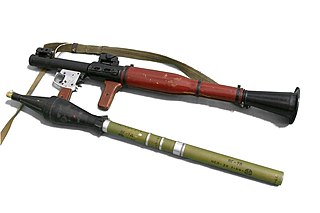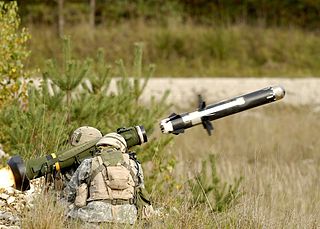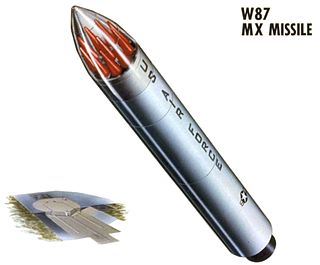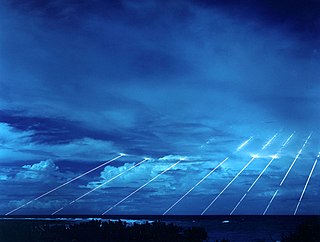
An anti-ballistic missile (ABM) is a surface-to-air missile designed to counter ballistic missiles. Ballistic missiles are used to deliver nuclear, chemical, biological, or conventional warheads in a ballistic flight trajectory. The term "anti-ballistic missile" is a generic term conveying a system designed to intercept and destroy any type of ballistic threat, however it is commonly used for systems specifically designed to counter intercontinental ballistic missiles (ICBMs).

In modern language, a missile, also known as a guided missile, is a guided self-propelled system, as opposed to an unguided self-propelled munition, referred to as a rocket. Missiles have four system components: targeting or missile guidance, flight system, engine, and warhead. Missiles come in types adapted for different purposes: surface-to-surface and air-to-surface missiles, surface-to-air missiles, air-to-air missiles, and anti-satellite weapons. All known existing missiles are designed to be propelled during powered flight by chemical reactions inside a rocket engine, jet engine, or other type of engine. Non-self-propelled airborne explosive devices are generally referred to as shells and usually have a shorter range than missiles.

A rocket-propelled grenade is a shoulder-fired anti-tank weapon system that fires rockets equipped with an explosive warhead. Most RPGs can be carried by an individual soldier. These warheads are affixed to a rocket motor which propels the RPG towards the target and they are stabilized in flight with fins. Some types of RPG are reloadable with new rocket-propelled grenades, while others are single-use. RPGs, with some exceptions, are generally loaded from the muzzle.

An anti-tank guided missile (ATGM), anti-tank missile, anti-tank guided weapon (ATGW) or anti-armor guided weapon is a guided missile primarily designed to hit and destroy heavily armored military vehicles.

A multiple independently targetable reentry vehicle (MIRV) is a missile payload containing several warheads, each capable of being aimed to hit a different target. The concept is almost invariably associated with intercontinental ballistic missiles carrying thermonuclear warheads, even if not strictly being limited to them. By contrast, a unitary warhead is a single warhead on a single missile. An intermediate case is the multiple reentry vehicle (MRV) missile which carries several warheads which are dispersed but not individually aimed. Only China, France, Russian Federation and United States are currently confirmed to possess functional MIRV missile systems. India and Israel are known or suspected to be developing or possessing MIRVs.

Reactive armour is a type of vehicle armour that reacts in some way to the impact of a weapon to reduce the damage done to the vehicle being protected. It is most effective in protecting against shaped charges and specially hardened kinetic energy penetrators. The most common type is explosive reactive armour (ERA), but variants include self-limiting explosive reactive armour (SLERA), non-energetic reactive armour (NERA), non-explosive reactive armour (NxRA), and electric reactive armour. NERA and NxRA modules can withstand multiple hits, unlike ERA and SLERA, but a second hit in exactly the same location may potentially penetrate any of those.
A projectile is any object thrown into space by the exertion of a force. Although any object in motion through space may be called a projectile, the term more commonly refers to a ranged weapon. Mathematical equations of motion are used to analyze projectile trajectory.
An object projected at an angle to the horizontal has both the vertical and horizontal components of velocity. The vertical component of the velocity on the y-axis given as Vy=USin(teta) while the horizontal component of the velocity Vx=UCos(teta).
There are various terms used in projectiles at specific angle teta
1. Time to reach maximum height. It is symbolized as (t), which is the time taken for the projectile to reach the maximum height from the plane of projection. Mathematically, it is give as t=USin(teta)/g
Where g=acceleration due to gravity(app 10m/s²)
U= initial velocity (m/s)
teta= angle made by the projectile with the horizontal axis.

A high-explosive anti-tank (HEAT) warhead is a type of shaped charge explosive that uses the Munroe effect to penetrate thick tank armor. The warhead functions by having the explosive charge collapse a metal liner inside the warhead into a high-velocity superplastic jet. This superplastic jet is capable of penetrating armor steel to a depth of seven or more times the diameter of the charge but is usually used to immobilize or destroy tanks. Due to the way they work, they do not have to be fired as fast as an armor piercing shell, allowing less recoil. Contrary to a widespread misconception, the jet does not melt its way through armor, as its effect is purely kinetic in nature. The HEAT warhead has become less effective against tanks and other armored vehicles due to the use of composite armor, explosive-reactive armor, and active protection systems which destroy the HEAT warhead before it hits the tank. Even though HEAT rounds are less effective against the heavy armor found on 2010s main battle tanks, HEAT warheads remain a threat against less-armored parts of a main battle tank and against lighter armored vehicles or unarmored vehicles and helicopters.

Military vehicles are commonly armoured to withstand the impact of shrapnel, bullets, missiles or shells, protecting the personnel inside from enemy fire. Such vehicles include armoured fighting vehicles like tanks, aircraft and ships.

The MGM-166 LOSAT was a United States anti-tank missile system designed by Lockheed Martin to defeat tanks and other individual targets. Instead of using a High Explosive Anti-Tank warhead like other anti-tank missiles, the LOSAT employed a solid steel kinetic energy penetrator to punch through armor. The LOSAT is fairly light; it was designed to be mounted onto a Humvee while allowing the vehicle to remain air-portable. LOSAT eventually emerged on an extended-length heavy-duty Humvee with a hard-top containing four KEMs used by special operations. Although LOSAT never "officially" entered service, it was used for the smaller Compact Kinetic Energy Missile.
An active protection system is a system designed to prevent line-of-sight guided anti-tank missiles/projectiles from acquiring and/or destroying a target.
A kinetic bombardment or a kinetic orbital strike is the hypothetical act of attacking a planetary surface with an inert projectile, where the destructive force comes from the kinetic energy of the projectile impacting at very high speeds. The concept originated during the Cold War.

Armor with two or more plates spaced a distance apart is called spaced armour. When sloped it reduces the penetrating power of bullets and solid shot, as after penetrating each plate they tend to tumble, deflect, deform, or disintegrate; when not sloped it increases the protection offered by the armour because explosive projectiles detonate on it before they reach the inner plates.
W70 is the designation for a tactical nuclear warhead developed by the United States in the early 1970s. The Lawrence Livermore National Laboratory designed W70 was used on the MGM-52 Lance. About 1250 were built in total. The warhead had a variable yield of between 1 and 100 kilotons, selectable by the user. The design dates from 1973.
The W68 warhead was the warhead used on the UGM-73 Poseidon SLBM missile. It was developed in the late 1960s at Lawrence Livermore National Laboratory.
The Compact Kinetic Energy Missile (CKEM) was a developmental program to produce a hypersonic anti-tank guided missile for the U.S. Army. Lockheed Martin was the primary contractor. The program was the third in a series of projects based on kinetic energy missiles that stretches back to 1981's Vought HVM through the 1990s LOSAT and finally to the CKEM. The Army Aviation and Missile Command (AMCOM) developed this program as part of the Army's Future Combat Systems. This missile was primarily an anti-tank weapon, and could be mounted on land vehicles and low-altitude aircraft. The goal of these weapons was to demonstrate a state-of-the-art system for the next generation. The program has since been cancelled.
Vought's HVM, short for Hyper-Velocity Missile, was an anti-tank missile developed during the 1980s. The HVM carried no warhead and killed its targets with kinetic energy alone using a metal rod penetrator. Development as an air-launched weapon for the A-10 Thunderbolt II ended sometime in the late 1980s but continued for helicopter use into the 1990s along with ground-launched (HMMWV) as the larger MGM-166 LOSAT. None of these systems was operationally deployed.
An anti-ship ballistic missile (ASBM) is a military quasiballistic missile system designed to hit a warship at sea.
Beyond-armour effect is a term coined by Försvarets Fabriksverk (FFV), a semi-governmental Swedish defense firm, while developing the AT4. From the 1980s this phrase was used in its brochures, press releases, weapon instruction manuals and other documentation to denote the post-penetration effect of the AT4's HEAT anti-armour warhead against the interior and occupants of armoured vehicles.














